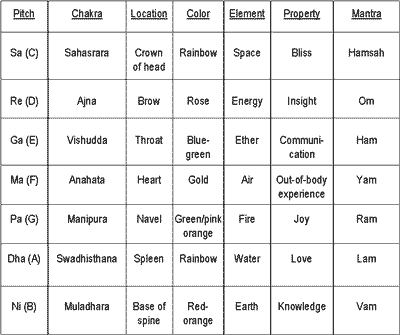 Electronic Music
Electronic Music
TRONIK INVOLUTIONS
INSCAPES FROM EXILE
S.O.S.W.T.C
THE SOUNDLESS SOUND
Tronik Involutions
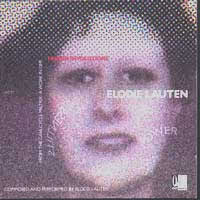
COMPOSER'S
NOTES
The
music
of Tronik Involutions is based on what I call Universal Mode Improvisation
(UMI), the creation of new modes combining classical key structures
and other nonwestern modal structures, allowing open-ended, free improvisation.
This also offers the possibility of more complex harmonies - which can
go from tonal to bitonal to atonal within the same piece - and by an absolute
use of improvisation - i.e., the electronic drums tracks are not automated,
they are actually improvised on a multitimbral keyboard. Tronik Involutions
consists of three basic layers: rhythm track and 'ghost' orchestra which
are the taped playback, and keyboard improvisation which is performed
live.
It is a development of my exploration of the experience of time (which I started with Variations on the Orange Cycle), as it connects to universal time and human perception of life cycles. Both works, Tronik Involutions and Variations on the Orange Cycle are "Earth Works" - they are based on earth tones, the 24-hour tone (Variations) and the yearly tone (Tronik).
The Gaia Cycle is the initial matrix title of Tronik Involutions. The Gaia Cycle is a musical mandala revolving around the Earth Tone, the sound corresponding to the earthís yearly cycle around the sun. It is composed of 12 five-minute sections corresponding to 12 months and 12 hexagrams of the I Ching, each in a different tonality/mode.
The piece stemmed from the possibilities offered by the principle that any cycle can be expressed in terms of frequency, therefore sound, and that any frequency can be transposed to a perceptible range by way of octave transposition Ė the same way a child sings a melody along with an adult in what appears to be unison, even though the child sings one octave higher.
The choice of the Earth Tone as a basis for a new body of work reflects an effort to ground the music to a new reference pitch set to low C# = 136 Hz, as opposed to the artificial and often criticized middle A=440. This low C# coincidentally happens to be the "Sa" or universal tonic of Indian music.
The general structure of the work is focused on a key change dynamic which follows a similar logic to that of J.S. Bachís Well Tempered Klavier: It uses the succession of sharps and flats as a hierarchical device. However, the keys used in The Gaia Cycle are expanded tonalities including elements of Western and nonwestern modes.
Unlike Vivaldiís Four Seasons, The Gaia Cycle does not attempt to literally translate the mood of any particular time of the year Ė after all, on the global scale, winter in Australia is summer in Canada. It expresses a desire to communicate the vitality of the experience of time, as in Marcel Proustís Remembrance of Things Past, and to maintain an awareness of climactic, psychic and social influences affecting the musical stream.
Technically, the piece is constructed from several electronic layers: percussion soundtrack generated by playing live patterns on a multitimbral keyboard, avoiding automatic sequencing; harmonic ghost orchestra soundtrack; and live electronic keyboard lead(s). Besides the selection of a new reference pitch, the tunings used on the electronic keyboard are either Vallotti or Just Intonation.
A quote from the New York Times
"...a peaceful
sense of stasis -- every section has its distinctive timbre, movement
and emotional quality. "The Gaia Cycle" seems less interested in creating
order than in finding order in natural processes. There is a certain serenity
in this kind of acceptance."
Bernard Holland
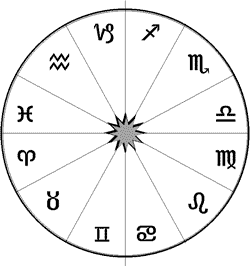
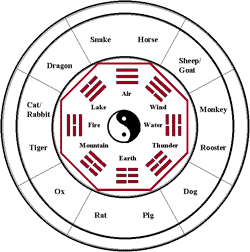
The above diagrams show two corresponding 12-part hierarchies, Western and Chinese astrology. The macro structure of Tronik Involutions is based on this universal 12-part hierarchy, which also corresponds to the 12 months of the year cycle. The diagram below shows the I Ching hexagram sequence corresponding to the 12 months. The logic is the following: starting with Earth/The Receptive(six broken lines) at the bottom, going in a clockwise direction, one line is added at the bottom of the hexagram and it becomes Return. Add one more line and it becomes Approach, etc. until the 12-part cycle is completed. In the I Ching, the change of a line from broken to continuous is a metaphor of evolution. Each situation evolves into another.
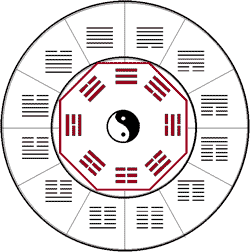
The concept of the piece was to match the change by a change of key signature. The first key signature was determined by the earth tone pitch of C# at 136.1 Hz, therefore it is a C# minor beginning the cycle. The next key signature is determined by the removal of one sharp - therefore only 3 sharps, F# minor, next two sharps, B minor, next one sharp, E minor, next no sharps, A minor, next one flat, F major, etc., as shown on the diagram below.
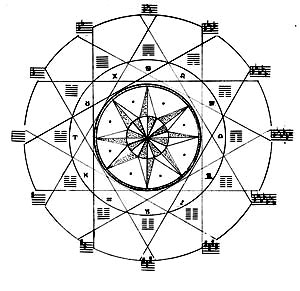
Liner Notes by Kyle Gann
If there is a special place in music heaven for Americaís "outsiderí composers, Elodie Lauten has earned her niche in it. Despite a string of critical successes reaching back into the 70ís, she remains a shadowy figure on the New York scene, with a reputation as a reclusive mystic. Not one to push her name in front of the public, she emerges every few years with an amazing new work - The Death of Don Juan, Concerto for Piano and Orchestral Memory, Existence, Sonate Ordinaire - and then retreats to nurture the unhurried gestation of her next offering. America doesnít know what to do with these artists so devoted to their inspiration that they wonít make concessions to commercial pressures. But gradually, as with such earlier reclusive outsiders as Charles Ives, Conlon Nancarrow, and LaMonte Young, audiences catch on.
Born in Paris, the daughter of jazz drummer/pianist Errol Parker and one of the few students of that master of endless drones LaMonte Young, Lauten has filtered her dual jazz and minimalist influences through a philosophy of complementary opposites operating throughout the cosmos. Tronik Involutions is the first manifestation of what Lauten calls The Gaia Cycle, a musical mandala sheís created correlating the earthís yearly cycle to the 12 tonalities, the 12 signs of the zodiac and 12 of the 64 hexagrams of the I Ching, the ancient Chinese Book of Changes.
The I Ching, a random oracle most often consulted in the West by throwing three coins six times to yield a hexagram of six lines, was made famous in the art world by John Cage, who used it to obtain chance numbers for note-to-note decisions in his music. Lauten, however, is more interested in the meaning of the hexagrams.
Tronik Involutions opens with Stillness, which is Lautenís rendering of hexagram No. 12 called "Standstill" in the popular Wilhelm/Baynes translation. The I Ching image is of heaven and earth moving apart from one another, "out of communion", in which case "the superior man falls back upon his inner world to escape the difficulties". Lauten correlates "Stillness" with a key signature of five flats - B flat minor - and the music depicts a state a subdued equilibrium, a calm three-note voice motif floating over a balanced drum pattern.
The second movement, Power (I Ching: The Power of the Great) is expressed in a signature of no sharps or flats. The image is of an upward movement of great power, but with the danger that power will "degenerate into mere force, if not inwardly united with the fundamental principles of right and justice." The musicís drumbeat is more active, more insistent, but the flutelike arabesques above it are uncertain, flitting ephemerally from one mode to another.
The third image, "Retreat", hostile forces are advancing, and success consists in reading the signs of the time correctly and in retreating in such a way to lay the groundwork for a counterattack at a more propitious moment. The musicís scintillating, silvery lines in F minor, like impossibly quick bowed vibraphones, indicate a turning inward, a refraining from direct action.
After all, Lautenís aim isnít to promote intellectual understanding of the I Ching, but to induce meditation on the mysteries of human existence, of which the I Ching is merely one of the most ancient and neatly systematized expressions.
The music is entirely improvised in an idiom that Lauten calls Universal Mode Improvisation, which combines all possible modes and allows her to slide smoothly from tonal music to bitonality to atonality within one piece. The overall tonality of the work is based on a C-sharp of 136.1 cycles per second, 32 octaves above the yearly revolution of the earth itself, 365.2422 days; interestingly, the pitch is also the "Sa" tone on which India raga singing is based. The scale is sometimes tuned to the pure, beatless intervals of just intonation, which is then combined with 18th-century Vallotti tuning for a shimmering inharmonicity. The musicís vibrant warmth, though, stems from Lautenís detailed ornamentation. Even the drum patterns are note automated, but improvised live on a multitimbral keyboard. As always, Lautenís melodies spin in space; patterns return, the same bass line comes back again, yet the music continuously evolves. Is there a loop, or just the evocation of an Eternal Recurrence? Actually, there is no literal repetition, but the music is so complex that only fully absorbed listening will verify the fact.
In Tronik Involutions that stasis has the effect of drawing us deeper into the ornate interplay of overlapping lines,. Within the self-imposed limitations of her medium Lauten has created an ingeniously varied universe, like a series of Bach preludes and fugues. As she rotates us through all the available keys and modes, we succumb to the exotically bitonal mystery of Encounter, the vibrant joyousness of Heaven, the dancelike aggressiveness of Approach; and we hear existence diffracted into a prism of colors of which, in our daily lives, we are only dimly aware. Perhaps Lautenís seductive, elusive music seems mysterious only because it points us to the mystery of life.
PRESS QUOTES
"Mesmerizing keyboard work. The music on this CD is quite extraordinary." OPTION MAGAZINE
"Powerful, spontaneous and enlightening." THE SANTA FE SUN
"Unforgettable. Sounds like food for the soul." NOW MAGAZINE (Canada)
"An extraordinary revelation." NEW HOPE INTERNATIONAL (England)
Copyright Elodie Lauten 2007
|
Inscapes from Exile |
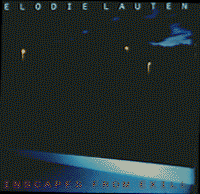 |
Label:
Felmay/New Tone INSCAPES FROM EXILE is a concept album, an electronic composition inspired by the history, myths and legends of New Mexico. The pieces were composed in 1994-95 in Albuquerque and I perceived this two-year period as a double exile from her place of birth, Paris and her place of adoption, New York. The music is drone based - a postminimalist starting point - but what makes it different is the microtonality of its electronic layers. Microtonality is defined as the use of any tuning/temperament other than the standard A=400/equal temperament. The synthesis process includes several types of unusual tunings, sometimes used in simultaneous layers. The textures can be complex. Again, like in TRONIK INVOLUTIONS, no sequencing takes place. Everything is played live, including the spinningly fast Barbie pieces. As a keyboardist, I focus, beyond synthesis, in the playing of the electronic sounds - in most programs used in this work, the amount of pressure applied on the keys triggers slightly different tonal colors - and I am playing the sound ‘from within’, letting it trigger an almost organic development of its own characteristics. INSCAPES is not landscape music, it is rather a musical journey, a kind of electronic On the Road, but there is a sub-text: it is an existential journey more than a physical one, a exploration of inner more than outer reality. There are three levels of exploration: the physical experience of a place (passive), the mental experience a place (receptive), and the introspection triggered by the experience (active). This approach is expressed in the poem Three Red Dots (see booklet), preceding the last piece, Unknown Presence at the Mesa. The first piece, Gusty Winds May Exist, is named after an oddly poetic road sign often seen on the highways. A long car ride through barren vistas is the unavoidable prelude to any experience in New Mexico. The focus is on the unseen. In the desert, or tundra, one is faced with an almost extra-terrestrial reality: the horizon displays itself so widely, opening to space and infinity, and there is a sense of unexplained presence, the nature of which can be left to the imagination - is it the memories of long lost civilizations or visitations of alien or spiritual origin?... The journey starts with Roswell. Here the subtext is the familiar so-called Roswell incident. The story goes: a UFO crashed in Roswell along with its alien crew, and some of them of may have been alive - all of which was denied by the US army but the truth remains a mystery. This story triggers two movements: Changing Gravity, Clearly Identified Floating Objects. The two ‘Barbie" pieces, Barbie’s Abduction and Barbie’s Fugue State express opposite viewpoints on alien abductions: one the one hand, some people believe they have had an abduction experience which feels real to them; on the other hand, there is a strong possibility that it is only a ‘fugue state’, an amnesiac state in which the person temporarily does not recall where they were, why, or who they are. Ordinary Spatial Distance is about adjusting to ordinary reality. The next stop on the journey, entitled Quantesaurus, recalls a visit to the petroglyphs, or prehistoric stone carvings on deserted hilltops of black volcanic stone, which stand as witnesses of a lost world. The journey continues through Hispanic pueblos - Lost in Los Lunas - two or three houses, and a restaurant, closed, with a sign on the door: Hot food on Tuesdays. Such sites bring a feeling of exile in space and time, as if one had suddenly and unwittingly been thrown into the past. The song At The Sundown, in memory of Geronimo, was given to me by a Sioux soprano, Bonnie Jo Hunt, whom she met during sessions for the TBS documentary The Native Americans. The lyrics are an early 20th century translation of the folk song. The Mesa piece was inspired by Chaco Canyon. Chaco Canyon in no tourist spot: you have to ride through 25 miles of dirt road before getting to the kivas and ruins of the ancient city, and at dusk it is particularly desolate. The site itself, a very wide canyon carved into red cliffs, is of incredible beauty. The whole experience is overwhelming. I felt a strong empathy with the Anasazi or "Ancient People". Their presence exuded anger and sadness, a kind of continuous mourning for those who have gone - as there are no more descendants of the Anasazi. In the music, it is expressed by the ghostly flute solo created from a series of samples of traditional Indian flute, played by ceremonial artist Ron Sunsinger. This piece was developed from The Kepler Matrix, a planet correspondence scheme inspired by the work of Kepler. Additional information on this matrix is on the concepts page. Copyright Elodie Lauten 2005 |
QUOTES Expanded
contrapuntal freedom, couched in unearthly timbres, creating a fluid feeling
of stationary motion, hovering busily in space." Layers
of melody, rhythm and color that are at once sophisticated and transparent.
EXPOSE
|
|
|
The Soundless Sound (created in 1984, revisited in 1989, 1998, and 2003, with choreography) is an electronic ambience based on the harmonic vibration of silence - in other terms 'the sound of one hand clapping' which is not subject to time or space - and the performance invites all participants to share the experience. Silence is both impossible to attain and ever-present. The noisier the lifestyle, the more important it becomes to find one's silent voice, one silent space. This is a perception of the time-space continuum which is neither subjective nor objective - the 'soundless sound' simply exists, and one can tune into it. The Soundless Sound was created after a long practice of a Yogananda meditation technique; closing the ear lobes, one listens to the inner sound. This sound unfolded for me as a diatonic tone cluster, the resonance of the Seven Fundamentals (seven tones of a diatonic Pythagrorean scale i.e., C,D,E,F,G,A,B) sounding simultaneously, while harmonics rise and form oscillating patterns developing over time. In relation to an ordinary scale, the difference is that the actual frequencies of these tones range from the very low to the very high, over the entire span of human hearing (20-20,000 Hz). In the electronic piece, I added a 'limit tone' that is so high it is at the edge of hearing perception (maybe cats or dogs could hear it better than humans). In Vedic hierarchies, correspondence tables match the diatonic set of pitches with the chakras, or energy centers girating in the astral body (a few inches around the physical body) and corresponding to the crown of the head, the brow (between the eyes), the throat, the heart, the navel, the spleen and the genitals. Besides the charkas, the Vedic template shows corresponding elements and mantras (sacred sounds), and I used this as a departure for composing the piece electronically. For the time/space relationship I used the I Ching primary trigram family and its correspondences with geographic locations (North, South, East, West) and times of the day. This is where I derived the material for Nancy Zendora's choreography, suggesting the I Ching family archetypes (heaven, earth, lake, fire, water, wind, thunder, mountain/father, mother, 3 daughters and 3 sons) as the basis of interpretive characters, and/or combinations and situations for the dance. Note that tonight The Soundless Sound is presented as an excerpt. The full version has 8 parts of 8 minutes each, totaling 64 minutes. I plan to continue to work on this piece over my lifetime. So far, it was purposely never released on CD. It may be at some point when the time is right. It was performed at different stages of development in 1984 (Experimental Intermedia), 1991 (LaMama) and in 1998 at the Knitting Factory with seven live performers under the title Initiation to the Soundless Sound and the same year as an installation/performance within the group exhibition Degrees of Embodiment - Art and Mind Physics at Federal Reserve Gallery, Boston. The motivation for this body of work corresponds to a sense of responsibility in creating music/sound art that imparts a vision of universal harmony which I developed through years of study of cosmologies and universal hierarchies of various cultures - Vedic scriptures, I Ching, Pythagoras, Robert Fludd and the Alchemists, Newton, Kepler, and modern mathematicians Cousto and Mandelbrot. More information on The Soundless Sound is available on the Concepts page.
Copyright Elodie Lauten 2007
|
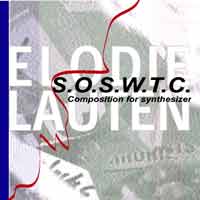
Listen
to excerpt
Mp3s and real audio files are available from Kalvos & Damian:
works by composers who reacted to the September 11 tragedy at www.kalvos.org/tragedy.html
Notes
S.O.S.W.T.C. follows previous releases Tronik Involutions (1996)
and Inscapes From Exile (1998) as a solo electronic album, but
departs in a new direction with the use concrete and indefinite pitch
percussion samples are the core of the sound design, along with pitched
and sliding tones. The sound components are controlled via the touch sensitivity
of the keyboard so that the improvisation literally ‘sculpts’ the sound,
allowing tri-dimensional control of melody, harmony and color. I have
explored concrete in earlier Piano Works (1983) and Concerto
For Piano And Orchestral Memory (1984), using ‘noise’ loops – pinball
machines, cars in the rain - as background. In S.O.S.W.T.C., the technology
is used to remodel concrete into instrumental color.
The general timing of S.O.S.W.T.C. follows the short-long morse code sequence of a S.O.S., i.e., three short, three long, three short. The succession of the 16 sections establishes a subliminal twin symmetry, with a disrupted S.O.S. (two short instead of three) at the beginning and the end.
The performance is direct, spontaneous, in tune with real life. One might identify impressions of floating in space, of descending like a leaf slowly falling from a tree; a sense of vulnerability, of a growling, ominous presence, of chaos, or merely of something wrong underneath the surface. If the piece was composed in reaction to the events surrounding the World Trade Center collapse, it is neither morbid nor elegiac. It is simply, in a Buddhist sense, a comment on reality without judgment, a meditation on the collective consciousness of the time. The experience – physical, emotional, spiritual – becomes awareness, and the awareness becomes music.
Elodie Lauten, November 26, 2001
